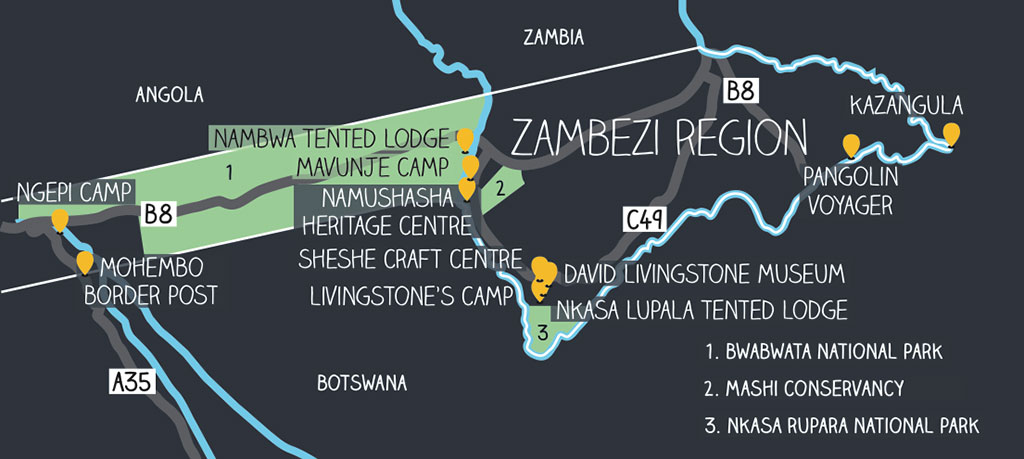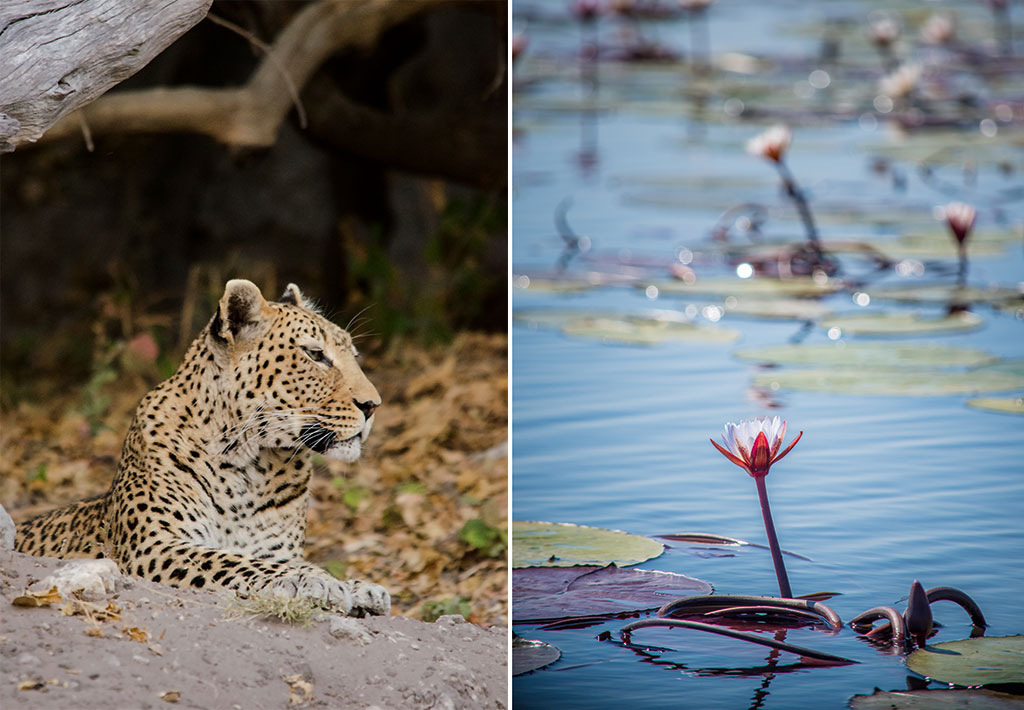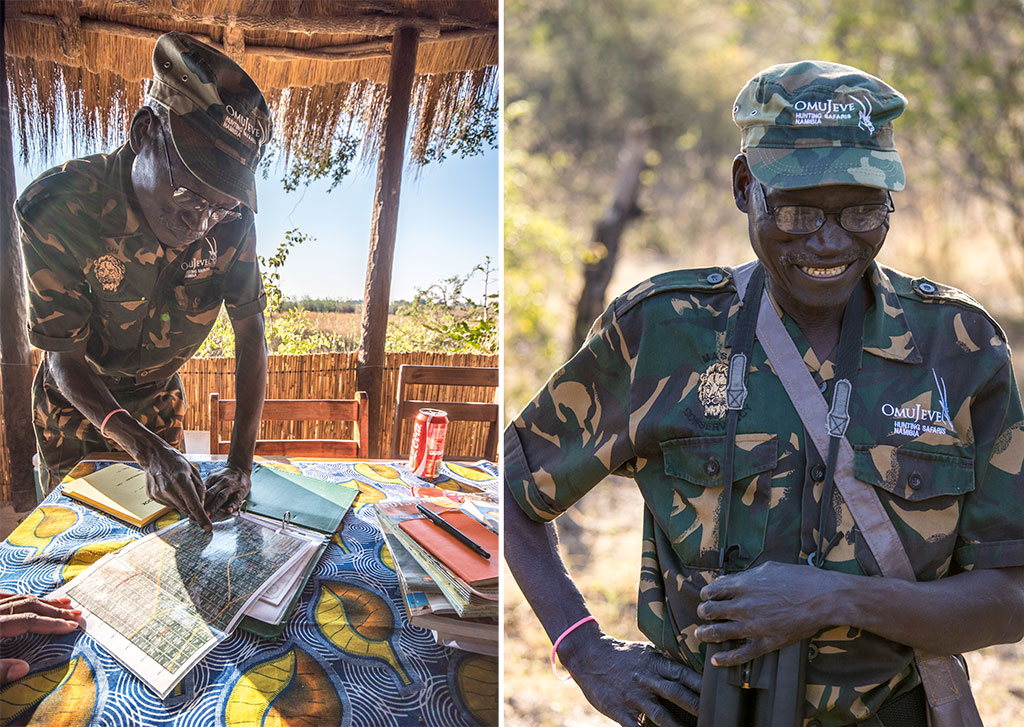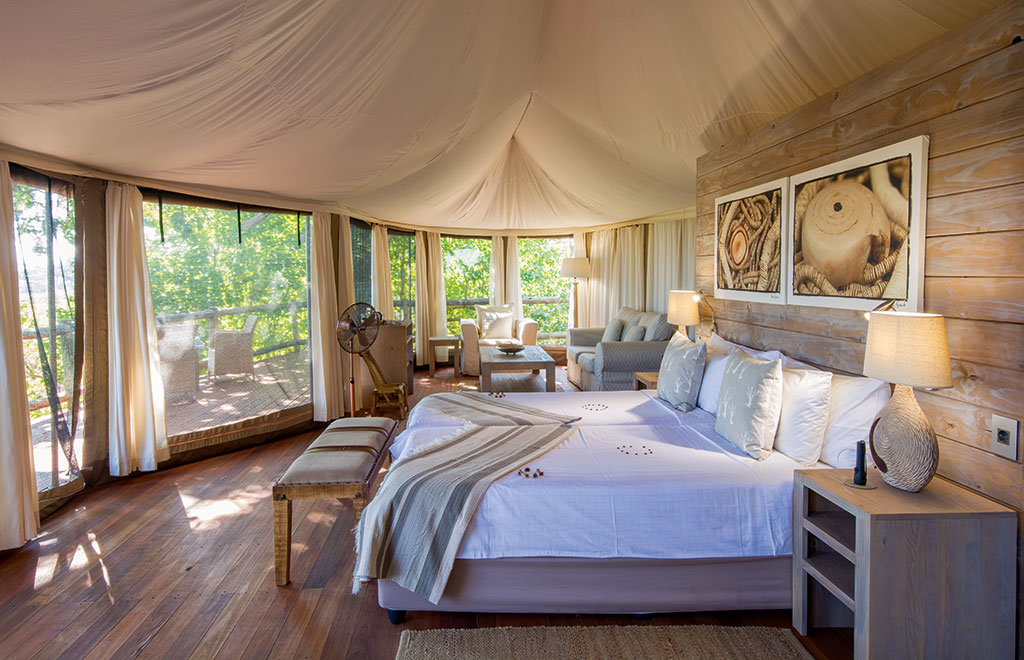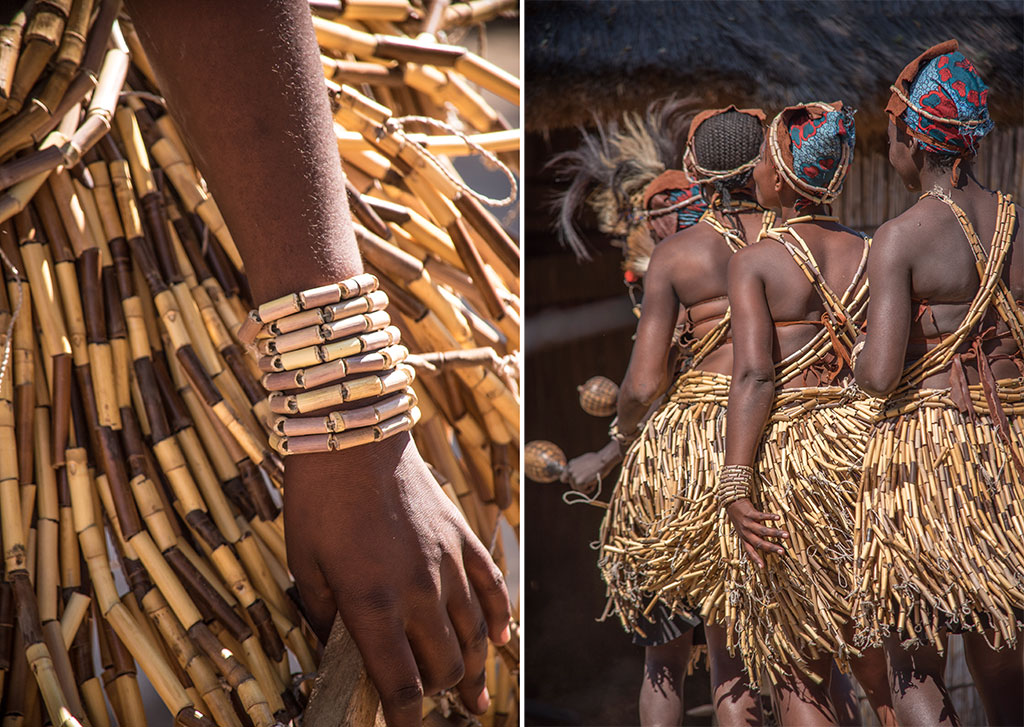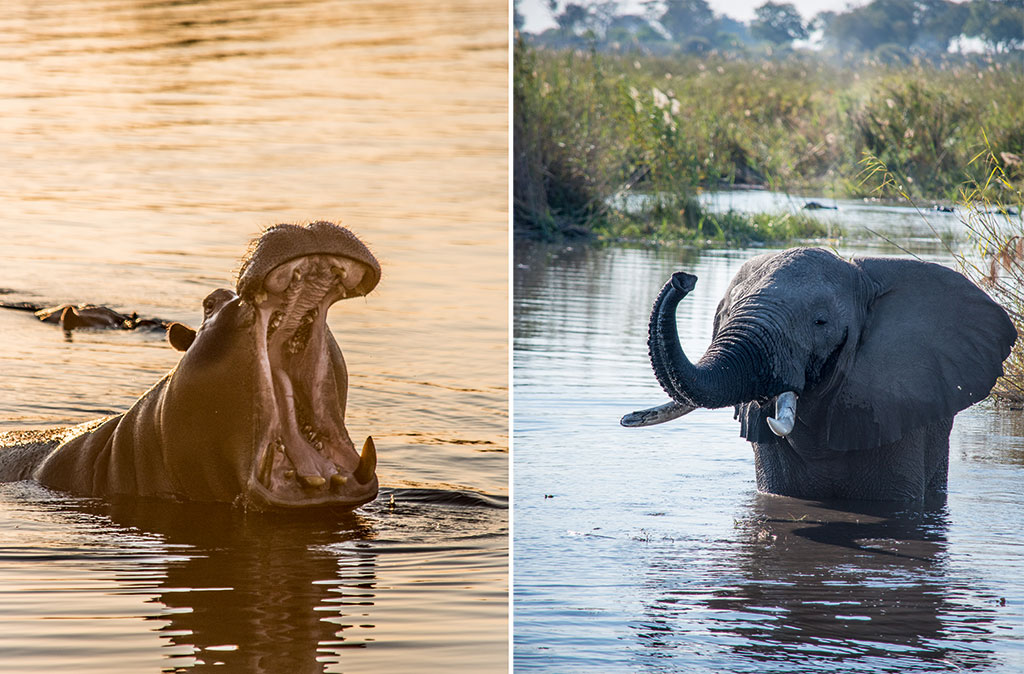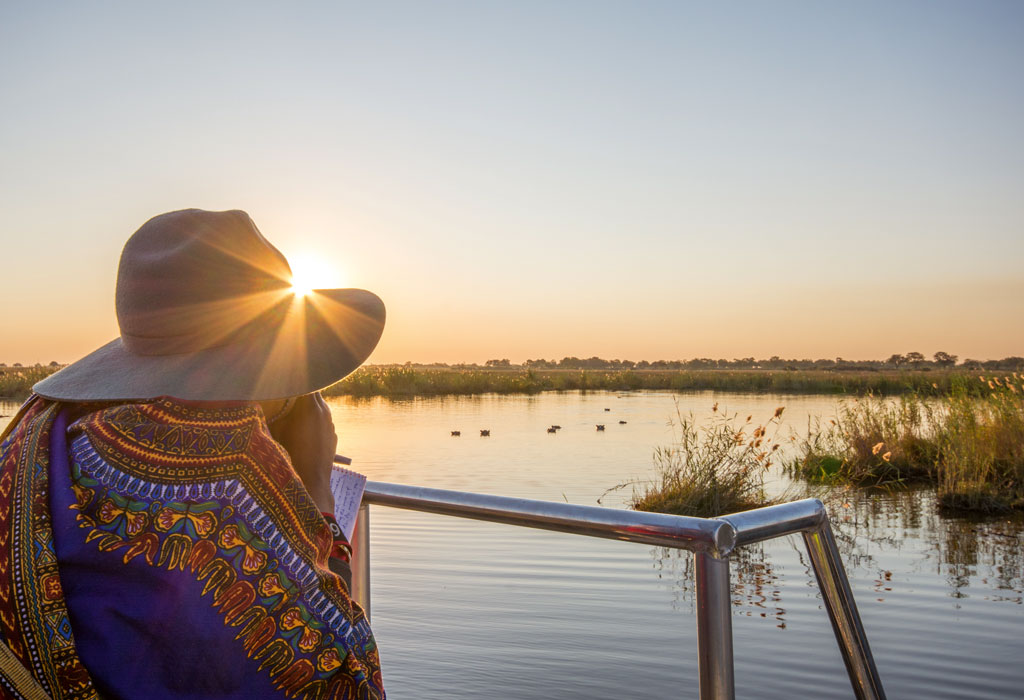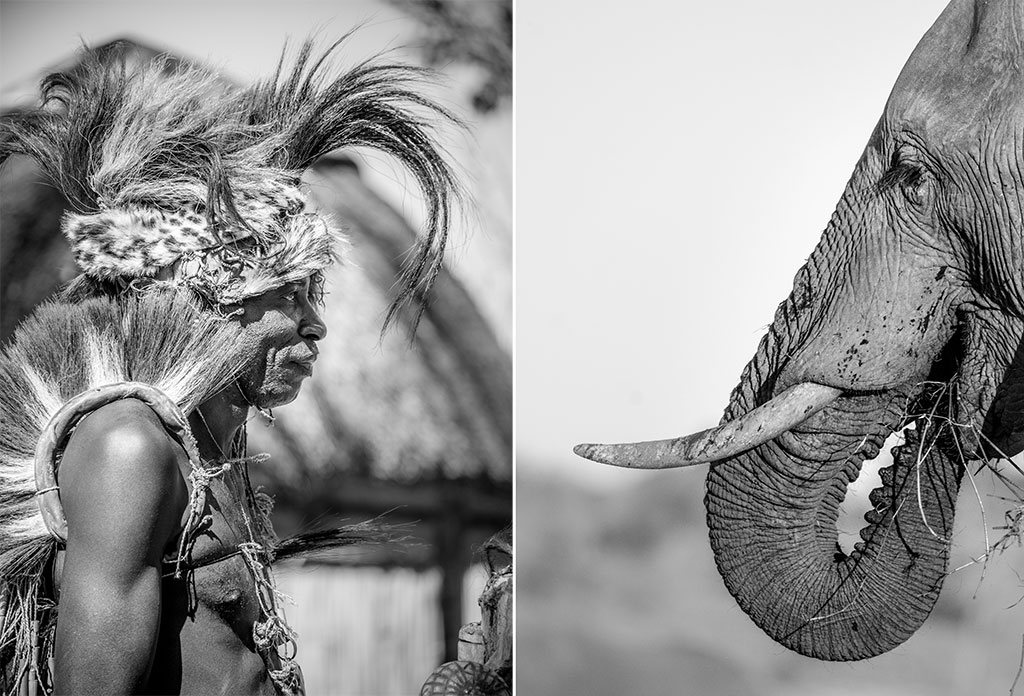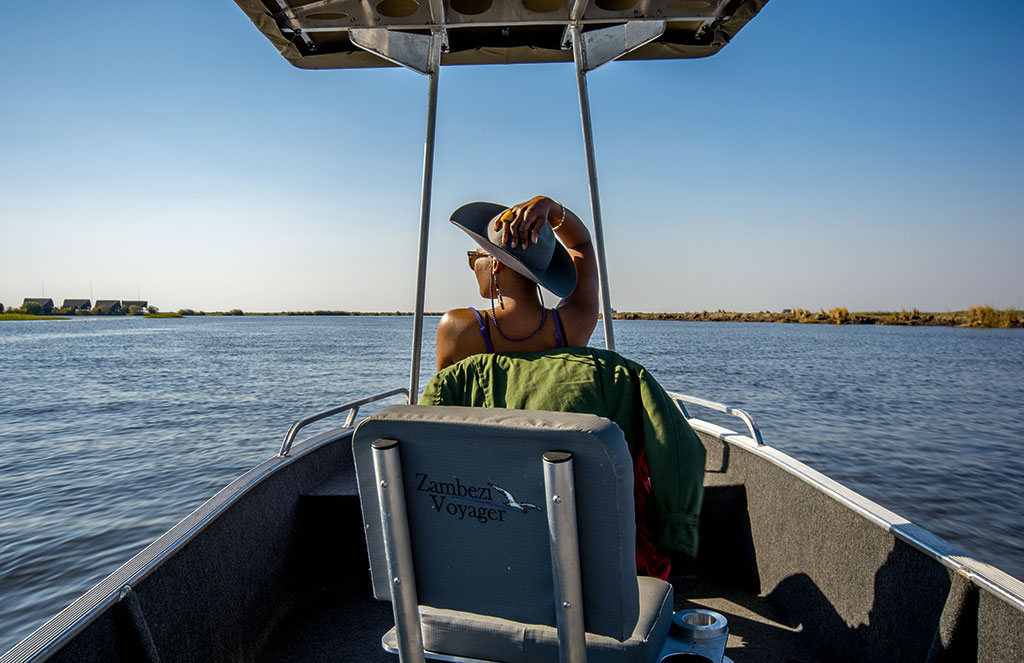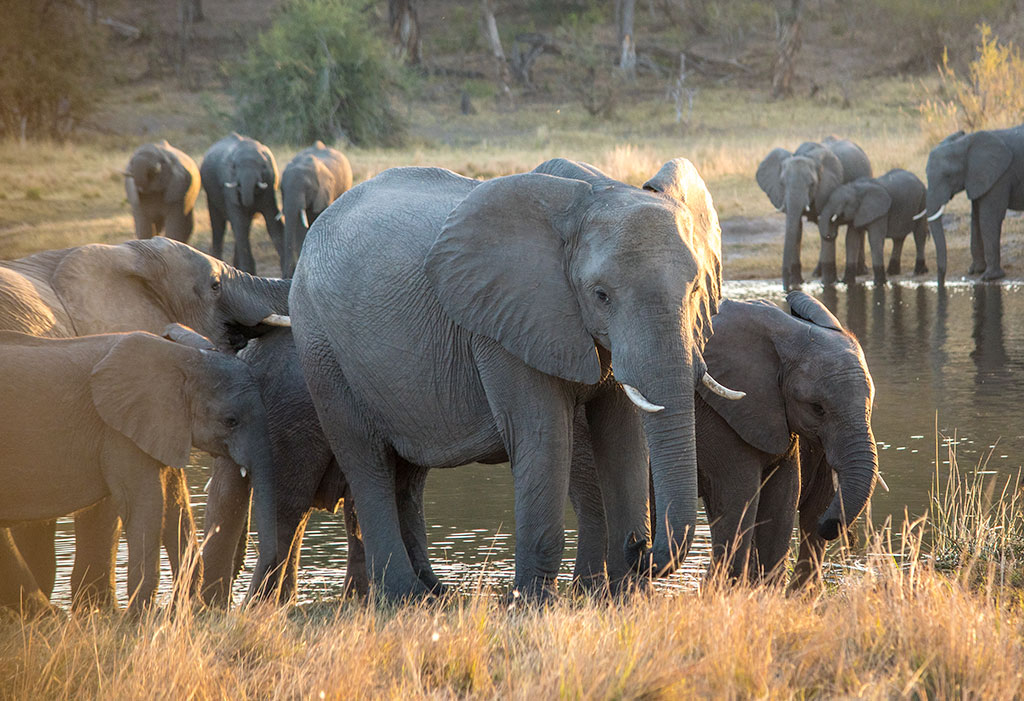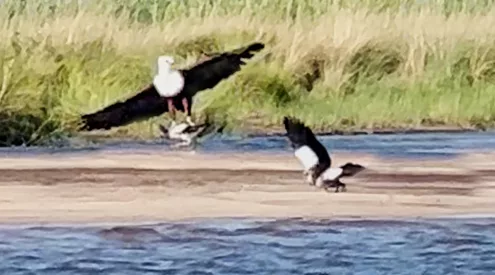Ever wanted to get up close – really close – to elephants? Getaway’s Vuyi Qubeka did, so she headed to Namibia’s Zambezi Region. Photographs by Melanie van Zyl.
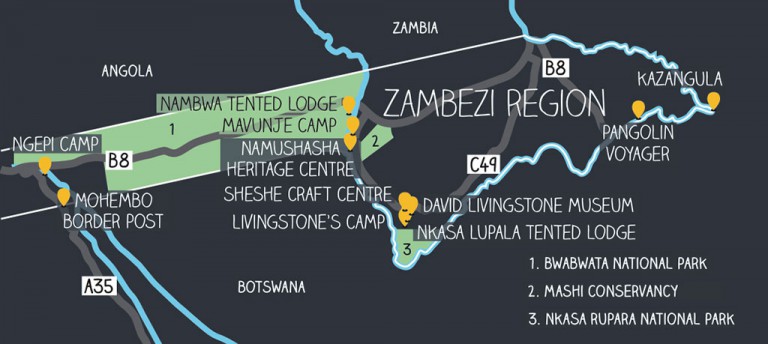
Conjuring the Caprivi
It’s the late 1800s and an arid-orange Namibia is under German rule. The rest of Africa is being carved up by European powers, laying lines over maps and divvying up everything they could get their hands on. In the colonial clamour it’s agreed that Germany will forsake its claim to Zanzibar in exchange for a narrow 500-kilometre-long finger of land. This is a strategic move. German South-West Africa had little water and German Chancellor Leo von Caprivi had a grand vision: to create a trade passage to Tanganyika and onwards to the Indian Ocean. Had he looked a little closer at the map, however, he would have noticed that Victoria Falls stood in his way, with a 100-metre drop to thwart his ambition. After World War I, South Africa took the reins in running South-West Africa, and the Caprivi Strip soon became a military zone – you can still spot remnants of old army bases in the national parks. During the Angolan Bush War (1966-1989), the Caprivi held an important strategic position, bordering four countries and providing a base of operations into the surrounding regions. In 2013 this odd strip of land was renamed the Zambezi Region.
Download: The BFGoodrich Getaway 4×4 Guide to Namibia
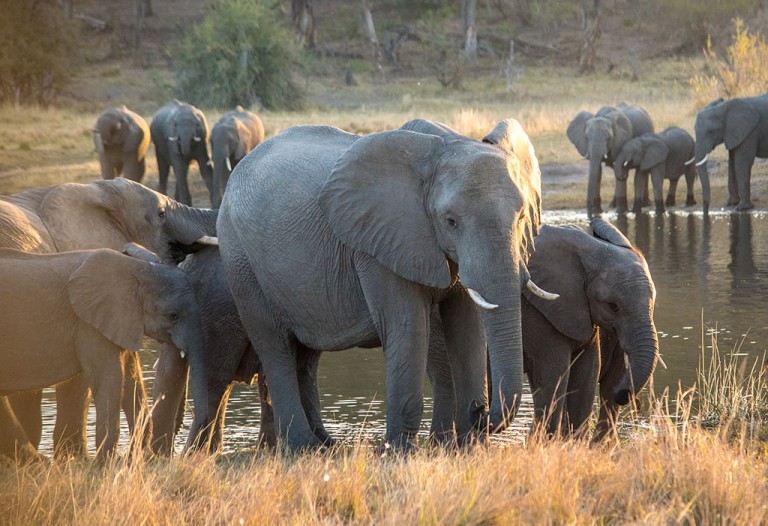
Elephants near Nambwa Tented Lodge.
In search of elephants
‘Tukuzime tu lapele.’
Alfred Nyazo Tunapu scanned the bush and then stopped.
‘What did he say?’ I whispered. Dan Stephens grabbed the hat off my head and pressed it to my chest. ‘We have to pray.’
‘Tukuzime tu lapele.’
Needles of sweat burst from my armpits, as is to be expected when you’re walking in the wild and a game guard with more than 25 years’ experience gives the order to pray in mbukushu (the language spoken by many people living along the Okavango River). My organs clenched. The silence cut into my ears. I could taste the mid-afternoon heat. Photographer and fellow adventurer Melanie Van Zyl turned to me, thrilled, ‘Well, you said you wanted adventure.’ And I did.
It was my fourth day in one of the wildest regions in the world. I was here to explore the relationship between Namibia’s wildlife and the people who live among it and, hopefully, fulfil a lifelong dream of getting up close to my favourite animals – elephants. I’d only been to Kruger for the first time a year ago, and that was in a car. For a long time, camping was to me what a township tour is to a tourist, or sheltered South African. I was an outsider, looking in, armed with preconceived notions and a hint of resistance. In less than a week I had leapfrogged from bush virgin to extreme adventurer, forging deep into the bush with Alfred and Dan, guide and owner of Mavunje Camp and Mashi River Safaris, on the banks of the Kwando River.
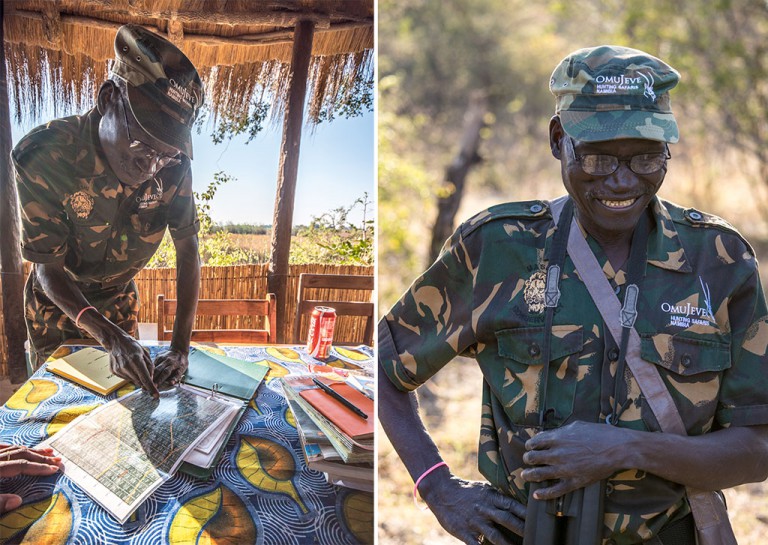
Alfred Nyazo Tunapu.
Alfred – an old man with a small but muscular frame and unfurrowed skin that belied his age – told us about the indigenous visionary, Chief Mayuni of the Mafwe tribe. In 1990, he started educating people about how conservation could help with hunger and poverty and today he is the chairman of the seven conservancies in the region. ‘Rupara was the first conservancy and Mashi is the last-born,’ Alfred said. Both Alfred and his brother were there from the beginning. Hunting in Mashi was introduced in 2003, and each conservancy has its own hunter who hunts for mostly international buyers. The money received from the buyer goes back into the conservancy to which the hunter belongs and the meat is shared with the community.
Alfred stopped and squinted. ‘He’s got a really good ear for the elephants,’ Dan whispered.
Slowly, we turned and moved in the opposite direction of the wind so the elephant couldn’t catch a whiff of us. We walked on. An hour or more had passed. Alfred picked up some elephant dung and told us about its various uses – as a mosquito repellent and, when mixed with chillies and burnt, as protection for maize crops from elephant invasions. Seriousness washed over Alfred’s face.
‘Keep completely still,’ he whispered. There they were: about 30 drinking at a watering hole some 400 metres away. More and more lumbered behind them. A loud trumpeting reverberated through the air, and thrummed in the boots Dan had leant me, and in my heart. It was a profoundly moving experience. Wild.
And that wasn’t even the first elephant I’d seen on this trip. Two nights earlier we’d experienced them in a different way: by car. On the way to Nambwa Lodge, a community-based enterprise within the Bwabwata National Park (created from Caprivi Game Park and Mahango Game Reserve), we took a detour to do some exploring before checking in. The park is majestic and peaceful and the views embrace the horizon. As we drove in, I spotted a huge matriarch behind one of the trees in the forest-like bush, a herd trailing behind her.
‘Look Mel!’ I said. We drove slowly… and there was another, and then some more. I felt a deep peace in the wind. Silence. Later, at sunset, we drove to Horseshoe Lagoon, the perennial oxbow lake on the Kwando River five minutes from the lodge, and found even more of these magnificent animals. By itself, an elephant is already stupefying. Put 30 or 40 drinking by a river in front of the dimming orange orb of sun – wow!
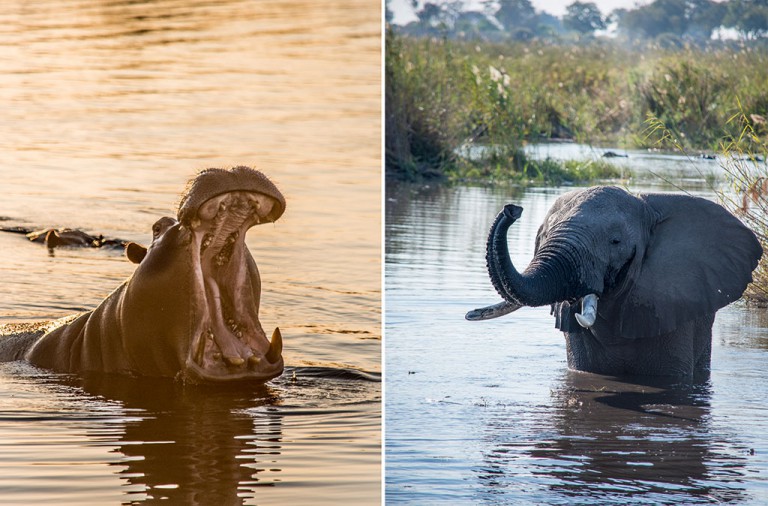
Hippo and elephant cool off in the river.
Then back at Nambwa Lodge, over a few G&Ts on the viewing deck, lodge manager Juan Marx came over and said, ‘Let me show you something.’ We walked along a raised wooden walkway towards the suites and there, a stone’s throw away, was another big group walking towards us. One elephant stretched its trunk upwards, wrapping it around the camelthorn and shaking it. Pods fell to the ground and the herd fed. Elephants have a grace and gentleness that’s palpable. In just a few days I’d seen so many, in so many different ways. Now I got the feeling that nature was just showing off.
Throughout this region, wild animals roam freely. They wander to neighbouring Angola, Botswana, Zambia and Zimbabwe. No fences. That’s the charm. It wasn’t always like this though. Game populations in the Zambezi panhandle were once pillaged in combat during the war for independence. Killing for meat was a necessity. Giraffe and black rhino became extinct locally.
Kenyan Nobel Peace Prize winner and environmental activist Wangari Maathai once said: ‘In a few decades, the relationship between the environment, resources and conflict may seem almost as obvious as the connection we see today between human rights, democracy and peace.’ This philosophy is evident here, where community-driven conservation initiatives are fostering democracy, sustainability and human dignity.
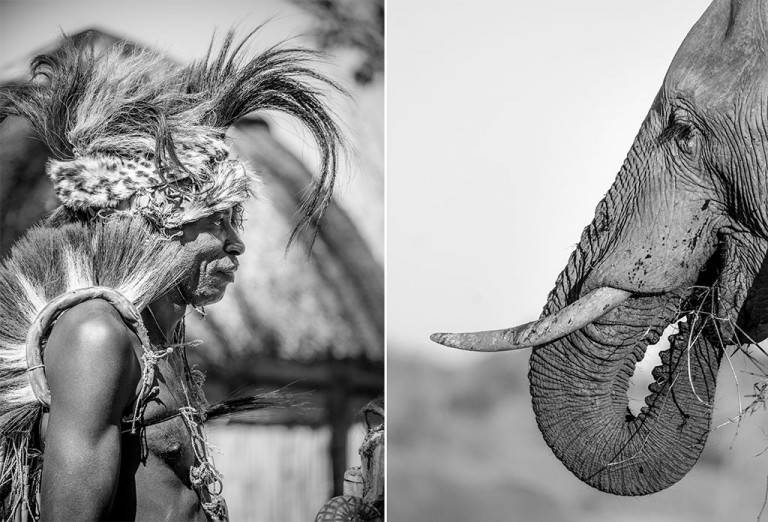
LEFT Visitors to the Namushasha Heritage Centre can get a feel of what traditional life is like in the Mashi community, as well as learning about agricultural practices and how to behave respectfully. Here, the traditional regalia worn by sangomas is displayed. RIGHT The mighty Chobe elephant.
After gaining independence in 1990, the Namibian government set about restoring the region with a Conservancy Development Support Grant Fund. Unlike other parks around the world, Namibia’s method is inclusive and the government is the first in the world to incorporate environmental protection into its constitution. It directs a share of funds generated from tourism to formerly disadvantaged Namibians (and official members of communal conservancies) while also boosting the numbers of species with low populations, increasing biodiversity and rehabilitating wildlife. This collaborative effort has reinstated populations of lions, zebras, cheetahs and other native wildlife. Today, there are seven conservancies in the region and much like it was many, many years ago, the communities of the Zambezi Region co-exist with the wildlife around them.
As I saw more of the region, the more I understood. People here are knowledgeable about history and nature. I learnt how the Linyanti River was formed but I also learnt about cultural practices – another point of pride for the people of the region.
Our last stop was the Pangolin Voyager Houseboat on the Chobe and Zambezi rivers. A speedboat from here took us on excursions and sunset rides. The Chobe River has about 10000 elephants and is overpopulated with crocodile. Elephants constantly surrounded me – babies and huge adults, crossing the water metres from me, the big ones helping the infants. On a trip with Pangolin Photo Safaris we watched in awe as a leopard strolled along the water’s edge and then lay in the sand, contemplating whatever leopards do.
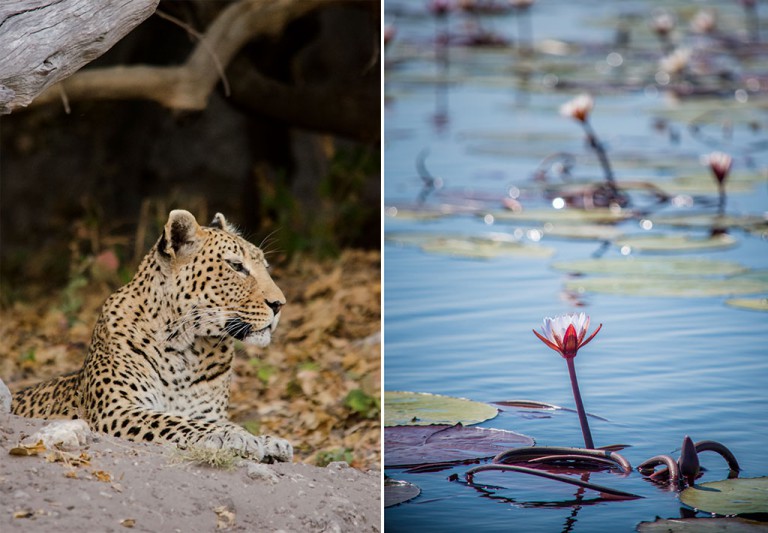
LEFT We spotted this leopard lounging next to the river in the Chobe national Park while on a river excursion with the team from the Pangolin Voyager Houseboat. RIGHT Waterlilies are used to make traditional dishes.
On these trips, I watched boat upon boat filled with tourists race to this nook for pictures of elephants and to that cranny for a photo of a fish eagle. I felt sorry for the animals. The energy of excited camera-toting tourists in big numbers must affect them.
It was on these waters in the more popular eastern section that it hit me how truly special, untamed and private the Zambezi region I’d just been in is: desolate, rough and barely anyone around. It’s the ultimate destination for wild adventure, culture and the conservation-minded. I thought about everything I’d seen. The way Namibia fiercely protects its wildlife and works at enhancing and protecting the livelihood of the people living in these areas reminded me of that elephant I’d seen at Nambwa. The one that shook the tree so all could eat. The co-habitation of animals and humans can be a benefit to all and here, in one of the wildest regions on Earth, not only is it working, it’s paramount to all species’ survival – and that’s recognised.
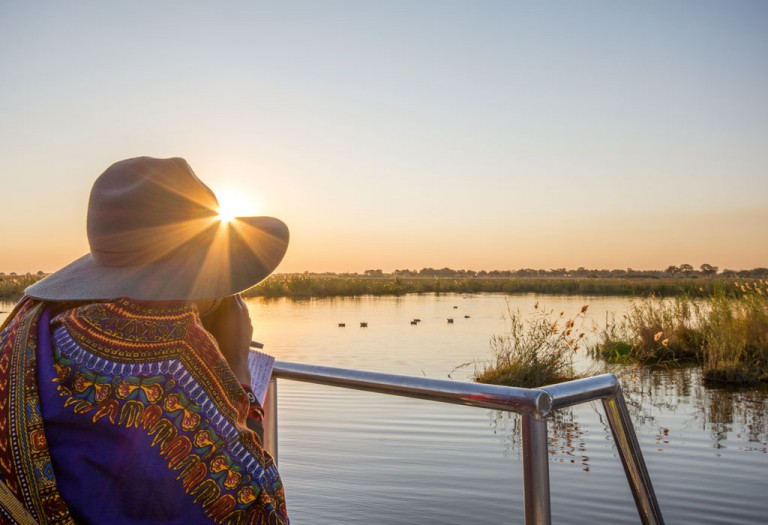
Sunset at Nkasa Rupara Park.
Plan your trip
Getting to the Zambezi Region
We drove a Toyota Hilux 4×4, rented from Bushtrackers, from Joburg through the Stockpoort border post to Botswana (about R235 per vehicle to enter) and into Namibia through the Mohembo border post (about R300). In the wet season many roads are inaccessible without a 4×4, but a high-clearance vehicle will get you by during the dry winter months. Rentals are fitted with all-terrain tyres, off-road nudge bars, long-range fuel tanks and a dual battery system. They’re available from Joburg, Windhoek or Kasane (subject to a delivery or return fee) from R950 per day.
Cash and fuel
R1 equals N$1 (Namibian dollar), but rands are widely accepted. South Africans don’t need a visa. There is fuel at Divundu, Kongola, Katima Mulilo and Rundu. ATMs are sparse so carry enough cash for emergencies.
Best time to visit the Zambezi Region
The dry season, June to November, is the best time to go.
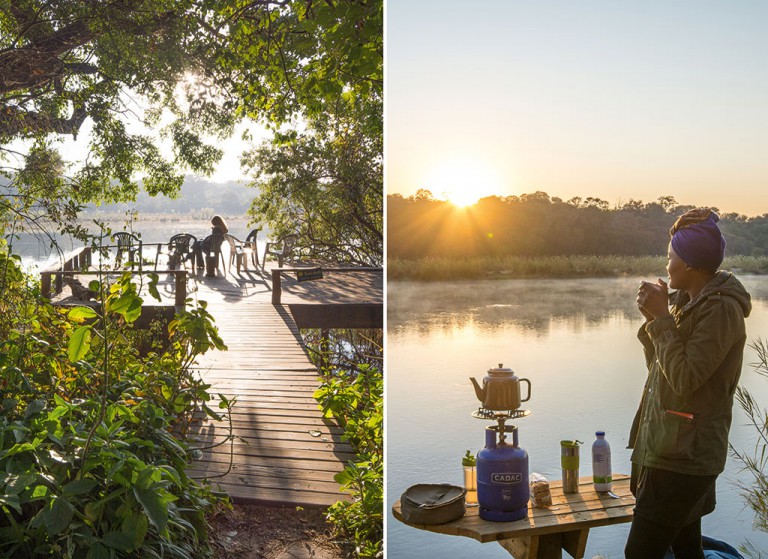
LEFT Ngepi Camp. RIGHT Me, enjoying a cuppa and the rising sun over the Okavango River.
Accommodation in the Zambezi Region
1. Ngepi Camp
Ngepi Camp is on an island in the Okavango Delta near the Bwabwata National Park. It’s both serene and funky and you’ll wish you had booked more than one night. We stayed in the en-suite solar-powered tree house at the river’s brink. B&B from R790 per person. Camping is from R120 per person.
2. Livingstone’s Camp
Livingstone’s Camp sites are quite large with a big kitchen area. Bring your own toilet paper, though. Site 3 has a good view. From R285 per person.
3. Rupara Community Campsite
Rupara Community Campsite is one of the few community-run camps. Some sites overlook the water and others are encased in bush. The loos have a view and there’s a donkey boiler for hot water. R80 per person. Tel +264815534616
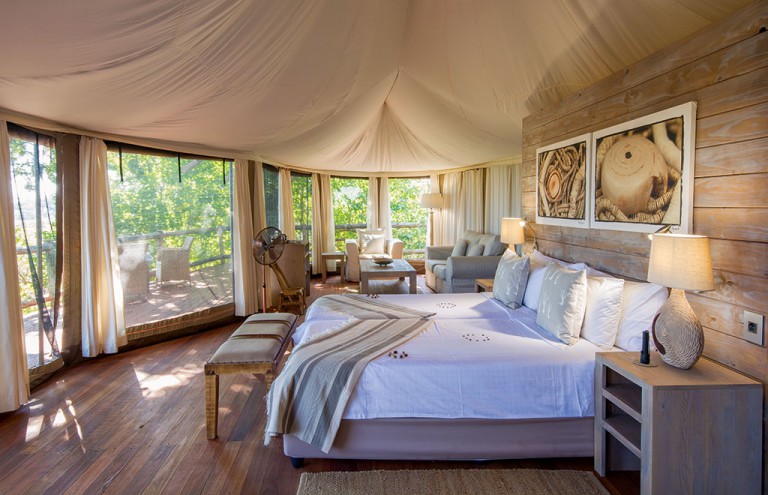
Nambwa Tented Lodge is beautifully decorated in chic earth tones.
4. Nambwa Tented Lodge
Nambwa Tented Lodge has well-appointed African-chic rooms, a tented campsite and a boma restaurant with views of the Kwando River. Expect sweet surprises in your room. It’s the only lodge in the area where night drives are permitted. From R6106 per person (all inclusive). Camping is R170, kids half price.
5. Mavunje Camp
Mavunje Camp lies on a lagoon and there are quirky details such as fairy lights in the bathrooms. It’s run in conjunction with the Mashi Conservancy. There are three campsites each with a separate bathroom and toilet, a dining area looking onto the river, and a fully equipped kitchen, with views of the floodplains. The focus is on private walking and river-based safaris. From R160 per person. A self-catering tented camp is also available from R320 per person.
6. The Pangolin Voyager
The Pangolin Voyager houseboat on the Namibian side, is a floating lodge on the Chobe and Zambezi River. I found the decor a bit outdated and I banged my head on the chunky painting on the headboard. But it was the perfect way to experience ‘a day in the life’ of the wildlife on the Chobe River. From R3000 per person (all inclusive).
Activities
1. Nkasa Rupara National Park
Take a game drive in Nkasa Rupara National Park, organised through Nkasa Lupala Tented Lodge. It’s a joint venture between the Italian Micheletti family and Wuparo Community Conservancy. From R400.
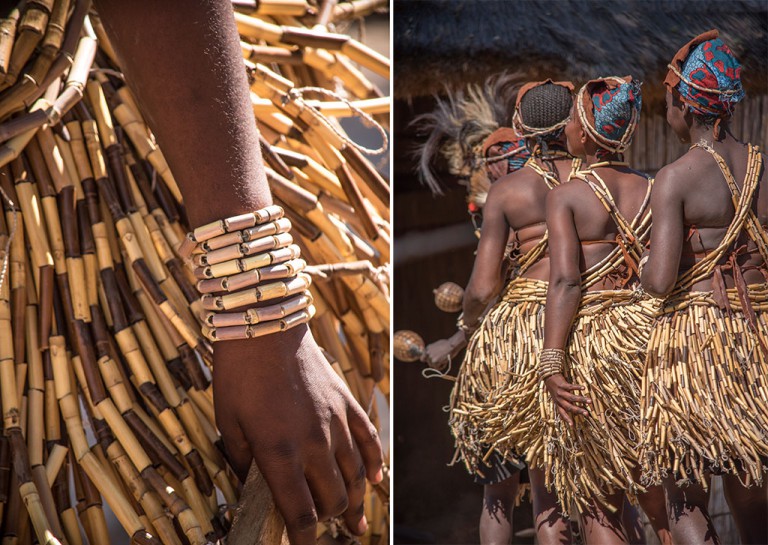
Dancers at namushasha Heritage Centre, a museum showcasing the history and traditions of the Lozi and Koloto tribes.
2. Namushasha Heritage Centre
Visit the Namushasha Heritage Centre at Kongola, a museum of the history and traditions of the Lozi and Kololo tribes, showcasing the way disputes within the community are handled by the ndunas (elders), how livestock is kept, to instruments played. Entrance is R80 per person.
3. The David Livingstone Museum
David Livingstone Museum in Mamili (Nkasa Lupala) National Park tells the story of Dr Livingstone and the history of the local tribes. Arrange a visit through Livingstone’s Camp. Free.
4. Mashi Conservancy
Do a walking trail in the Mashi Conservancy and get up close and personal with elephant (naturally), leopard and giraffe. R300 per person.
5. Mokoro trips
Take a mokoro trip on the Linyanti River at Livingstone’s Camp. Our trip was somewhat saddening – the water was low due to the drought, and you could almost see (and feel) the earth below. The best time is sunrise and sunset. R250 per person.
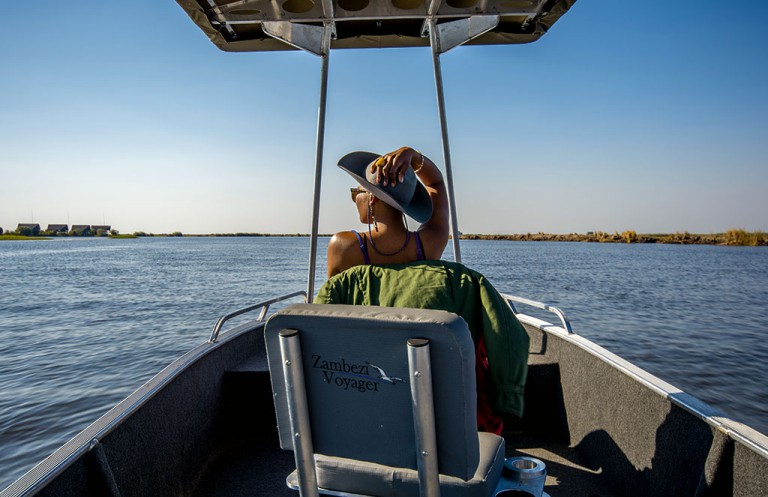
Looking for game on the banks of the Chobe River. The Pangolin Voyager Houseboat has two vessels to use for game- spotting, fishing or visiting Impalila Island.
6. Photo safari
Go on a photo safari with Pangolin Photo Safaris. It’s an intimate way to experience the wildlife, and you learn lots of photography tricks. R1450 per person for three hours (8GB SD card included, plus refreshments).
Shopping
Sheshe Craft Centre in Sangwali village sells well-priced crafts, including wooden bowls and carvings by residents of Wuparo and the neighbouring Dzoti Conservancy. It’s just north of the entrance into Nkasa Rupara National Park.
Please note that prices are subject to change at each establishment’s discretion. Please confirm with them before travelling.
See more: Photos from the wildest elephant assignment
This article was first published in the October 2015 issue of Getaway magazine.
Get this issue →
Also free with our October issue, and now available online – the Getaway 4×4 Guide to Botswana. Everything you need to know to plan a 4×4 trip to Botswana.










